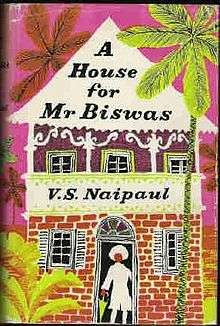A House for Mr Biswas
 First edition cover | |
| Author | V. S. Naipaul |
|---|---|
| Cover artist | Stephen Russ[1] |
| Country | United Kingdom |
| Language | English |
| Genre | Contemporary fiction |
| Published | 1961 André Deutsch |
| Media type | |
A House for Mr Biswas is a 1961 novel by V. S. Naipaul, significant as Naipaul's first work to achieve acclaim worldwide. It is the story of Mohun Biswas, an Indo-Trinidadian who continually strives for success and mostly fails, who marries into the Tulsi family only to find himself dominated by it, and who finally sets the goal of owning his own house. Drawing some elements from the life of Naipaul's father,[2][3] the work is primarily a sharply drawn look at life that uses postcolonial perspectives to view a vanished colonial world.
In 1998, the Modern Library ranked A House for Mr Biswas number 72 on its list of the 100 best English-language novels of the 20th century. Time magazine included the novel in its "TIME 100 Best English-language Novels from 1923 to 2005".
Plot
Mohun Biswas is born in rural Trinidad to parents of Indian origin. His birth was considered inauspicious as he is born "in the wrong way" and with an extra finger. A pandit prophesies that the newborn child "will be a lecher and a spendthrift. Possibly a liar as well", and that he will "eat up his mother and father". The pandit advises that the boy be kept "away from trees and water. Particularly water". A few years later, Mohun leads a neighbour's calf, which he is tending, to a stream. The boy, who has never seen water "in its natural form", becomes distracted and allows the calf to wander off. Mohun then hides in fear of punishment. His father, believing his son to be in the water, drowns in an attempt to save him, thus in part fulfilling the pandit's prophecy. This leads to the dissolution of the family. Mohun's sister is sent to live with a wealthy aunt and uncle, Tara and Ajodha. Mohun, his mother, and two older brothers go to live with other relatives.
The boy is withdrawn prematurely from school and apprenticed to a pandit, but is cast out on bad terms. Ajodha then puts him in the care of his alcoholic and abusive brother Bhandat, an arrangement which also ends badly. Finally, the young Mr Biswas decides to make his own fortune. He encounters a friend from his school days who helps him get into the business of sign-writing. While on the job, Mr Biswas attempts to romance a client's daughter but his advances are misinterpreted as a wedding proposal. He is drawn into a marriage which he does not have the nerve to stop and becomes a member of the Tulsi household.
Mr Biswas becomes very unhappy with his wife Shama and her overbearing family. The Tulsis (and the big decaying house where they live) represent the communal way of life which is traditional throughout Africa and Asia. Mr Biswas is offered a place in this cosmos, a subordinate place to be sure, but a place that is guaranteed and from which advancement is possible. But Mr Biswas wants more. He is, by instinct, a modern man. He wants to be the author of his own life. That is an aspiration with which Tulsis cannot deal, and their decaying world conspires to drag him down.[4] Despite his poor education, Mr Biswas becomes a journalist, has four children with Shama, and attempts several times to build a house that he can call his own, a house which will symbolize his independence.
Significance
This novel is generally regarded as Naipaul's most significant work and is credited with launching him into international fame and renown.
Time magazine included the novel in its "TIME 100 Best English-language Novels from 1923 to 2005".[5]
Adaptations
The novel was later adapted as a stage musical, with compositions by Monty Norman. One of the songs written for the play, "Good Sign, Bad Sign", was later rewritten as "The James Bond Theme", according to the documentary Inside Dr. No.
A two-part radio dramatisation, featuring Rudolph Walker, Nitin Ganatra, Nina Wadia, and Angela Wynter ran on BBC Radio Four on March 26 and April 2, 2006.
External links
References
- ↑ Bound books - a set on Flickr
- ↑ Kumar, Amitava (2002-01-01). Bombay--London--New York. Psychology Press. ISBN 9780415942119.
- ↑ Hayward, Helen (2002-01-01). The Enigma of V S Naipaul: Sources and Contexts. Palgrave Macmillan. ISBN 9781403902542.
- ↑ S. R. Cudjoe, V.S. Naipaul: A Materialist Reading, p.71. See also Ramchand, The West Indies, p. 206.
- ↑ "All-TIME 100 Novels: How We Picked the List". TIME.com. Retrieved 2016-07-05.